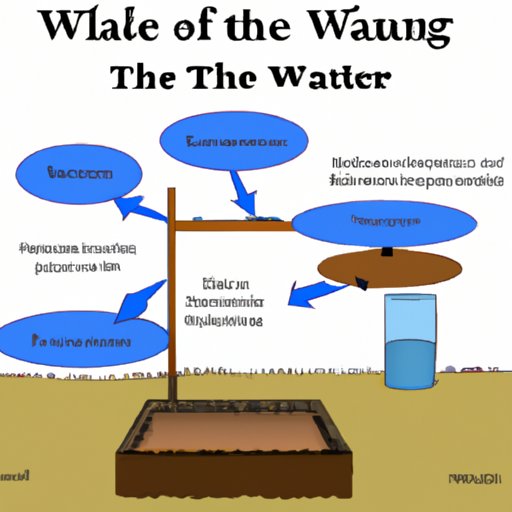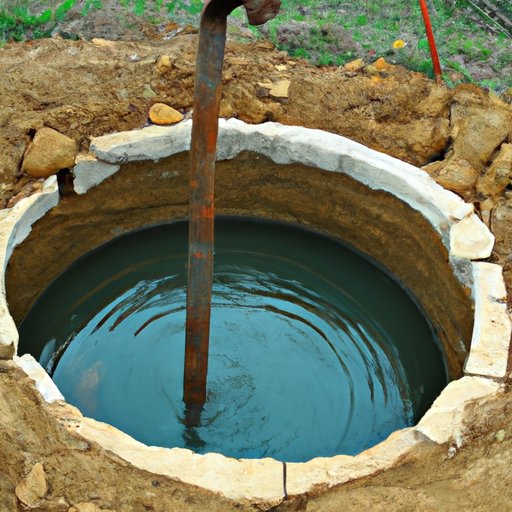Introduction
Well water is a popular water source for those who don’t have access to municipal water systems. But what exactly is well water and where does it come from? Knowing the answer to this question is important for ensuring that your well water is safe for drinking, bathing, and other uses.

Exploring the Science of Groundwater: How Well Water is Formed and Where it Comes From
Groundwater is a vital source of fresh water on Earth. It is found beneath the surface of the earth in the pores and cracks of rocks and soil. The water cycle is responsible for replenishing this underground water supply. Rainfall infiltrates the ground and collects in the pores and cracks of rock formations, creating an underground reservoir called an aquifer. This process is known as infiltration and is the main source of groundwater.
The geology of the area plays a big role in determining how much groundwater is available. Areas with porous rock formations like sandstone and limestone tend to have more groundwater than areas with hard rock formations, such as granite or shale. The type of aquifer is also important. Unconfined aquifers are the most common type and are not sealed by an impermeable layer. Confined aquifers, on the other hand, are sealed by an impermeable layer and can hold large amounts of water. Lastly, surface water such as lakes, rivers, and streams can also be used as a source of well water.
A Comprehensive Guide to Understanding Your Well Water Source
The first step in understanding your well water source is to determine the location of your well. Wells can be located in many different areas, including fields, backyards, and even inside buildings. The depth of the well can also vary greatly, ranging from a few feet to hundreds of feet. Knowing the exact location and depth of your well is important for determining the quality and quantity of the water.
Once you have determined the location of your well, it is important to test and monitor your well water regularly. Testing can help identify any contaminants that may be present in the water, such as bacteria, nitrates, or metals. Monitoring can help detect any changes in the water over time. Regular testing and monitoring can help ensure that your well water is safe for drinking, bathing, and other uses.
The Benefits of Well Water and How to Find the Best Source
Well water offers many benefits over municipal water. For starters, it is usually less expensive than municipal water, since there are no taxes or fees associated with it. Additionally, well water may contain minerals that can be beneficial for health, such as calcium and magnesium. Finally, well water is often considered to be more environmentally friendly than municipal water, since it doesn’t rely on chemical treatments or long-distance pipes.
When looking for the best source of well water, it is important to consider factors such as location, depth, and quality of the water. Location is important because the closer the well is to the surface, the easier it is to access the water. Depth is important because deeper wells tend to have better water quality. Finally, it is important to test and monitor the water regularly to ensure that it is safe for drinking and other uses.

Common Issues with Well Water and How to Protect Your Supply
Although well water is generally safe for drinking, there are certain issues that can arise. One of the most common issues is contamination. Contamination can occur when pollutants enter the groundwater, such as chemicals from fertilizer or runoff from roads. Additionally, low pressure can be an issue if the water table is too low or if the pump is not working properly. Poor taste can also be an issue, as some well water can have a metallic or sulfuric taste.
In order to protect your well water supply, it is important to take steps to prevent contamination. This includes avoiding fertilizers and chemicals near the well, properly disposing of hazardous materials, and avoiding activities that could cause erosion or runoff. Additionally, it is important to inspect your well and pump regularly to ensure they are functioning properly.

An Overview of the Different Types of Well Water and Their Sources
There are three main types of wells: artesian wells, dug wells, and borehole wells. Artesian wells are drilled into an aquifer and use pressure from the aquifer to bring the water to the surface. Dug wells are shallow wells that are dug by hand and use a pump to bring the water to the surface. Borehole wells are drilled deep into the ground and use pumps to bring the water to the surface.
Conclusion
Understanding where your well water comes from is important for ensuring that your well water is safe and of good quality. Groundwater is a vital source of fresh water and is found in the pores and cracks of rocks and soil. The geology of the area and the type of aquifer play an important role in determining the amount of groundwater available. Additionally, surface water such as lakes and rivers can also be used as a source of well water. Regular testing and monitoring of the water can help ensure that it is safe for drinking, bathing, and other uses.
Well water offers many benefits, such as cost savings, health benefits, and environmental friendliness. However, there are certain issues that can arise with well water, such as contamination, low pressure, and poor taste. In order to protect your well water supply, it is important to take steps to prevent contamination and inspect your well and pump regularly.
There are three main types of wells: artesian wells, dug wells, and borehole wells. Each has its own benefits and drawbacks, so it is important to do research to find the best source of well water for your needs. With the right care and maintenance, well water can be a safe and reliable source of fresh water for many years to come.
(Note: Is this article not meeting your expectations? Do you have knowledge or insights to share? Unlock new opportunities and expand your reach by joining our authors team. Click Registration to join us and share your expertise with our readers.)
